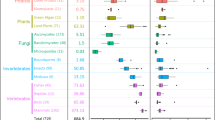Abstract
Tandemly repeated sequences are unique to eukaryotes and make up tens of percent of the higher eukaryote genome. However, the evolution of this class of sequences is poorly studied. In our paper, 62 families of Mus musculus tandem repeats are analyzed by bioinformatic methods, while 7 of them are analyzed by fluorescence in situ hybridization. It is shown that the same tandem repeat sets occur together only in closely related species of mice. However, even in such species, we observe differences in localization on chromosomes and the number of individual tandem repeats. With increasing evolutionary distance, only some of the tandem repeat families remain common for different species. It is shown that the use of a combination of bioinformatics and molecular biology techniques is very promising for further studies of tandem repeat evolution.
Similar content being viewed by others
Abbreviations
- periCEN:
-
pericentromeric region of chromosomes
- satDNA:
-
satellite DNA
- bp:
-
base pair
- TR:
-
tandem repeats
- CEN:
-
centromeric region of chromosomes
- SRA:
-
sequence read archive
- WGS:
-
whole genome shotgun
References
Arneson, N., Hughes, S., Houlston, R., and Done, S., Whole-genome amplification by degenerate oligonucleotide primed PCR (DOP-PCR), Cold Spring Harbor Protocol, 2008.
Benson, G., Tandem repeats finder: a program to analyze DNA sequence, Nucleic Acids Res., 1999, vol. 27, pp. 573–580.
Chevret, P., Veyrunes, F., and Britton-Davidian, J., Molecular phylogeny of the genus Mus (Rodentia: Murinae) based on mitochondrial and nuclear data, Biol. J. Linnean Soc., 2005, vol. 84, pp. 417–427.
Enukashvily, N., Donev, R., Sheer, D., and Podgornaya, O., Satellite DNA binding and cellular localisation of RNA helicase P68, J. Cell Sci., 2005, vol. 118, pp. 611–622.
Fry, K. and Salser, W., Nucleotide sequences of HS-a satellite DNA from kangaroo rat Dipodomys ordii and characterization of similar sequences in other rodents, Cell, 1977, vol. 12, pp. 1069–1084.
Garagna, S., Marziliano, N., Zuccotti, M., Searle, J.B., Capanna, E., and Redi, C.A., Pericentromeric organization at the fusion point of mouse robertsonian translocation chromosomes, Proc. Natl. Acad. Sci. USA, 2001, vol. 98, pp. 171–175.
Kalitsis, P., Griffiths, B., and Choo, K.H., Mouse telocentric sequences reveal a high rate of homogenization and possible role in Robertsonian translocation, Proc. Natl. Acad. Sci. USA, 2006, vol. 103, pp. 8786–8791.
Kipling, D., Mitchell, A.R., Masumoto, H., Wilson, H.E., Nicol, L., and Cooke, H.J., CENP-B binds a novel centromeric sequence in the Asian mouse Mus caroli, Mol. Cell. Biol., 1995, vol. 15, pp. 4009–4020.
Kit, S., Equilibrium sedimentation in density gradients of DNA preparations from animal tissues, J. Mol. Biol., 1961, vol. 3, pp. 711–716.
Komissarov, A.S., Gavrilova, E.V., Demin, S.J., Ishov, A.M., and Podgornaya, O.I., Tandemly repeated DNA families in the mouse genome, BMC Genom., 2011, vol. 12, p. 531.
Kuznetsova, I., Podgornaya, O., and FergusonSmith, M.A., High-resolution organization of mouse centromeric and pericentromeric DNA, Cytogenet. Genome Res., 2006, vol. 112, pp. 248–255.
Langmead, B. and Salzberg, S., Fast gapped-read alignment with Bowtie 2, Nature Methods, 2012, vol. 9, pp. 357–359.
Lobov, I.B., Tsutsui, K., Mitchell, A.R., and Podgornaya, O.I., Specificity of SAF-A and lamin B binding in vitro correlates with the satellite DNA bending state, J. Cell. Biochem., 2001, vol. 83, pp. 218–229.
Liu, Y.H., Takahashi, A., Kitano, T., Koide, T., Shiroishi, T., Moriwaki, K., and Saitou, N., Mosaic genealogy of the Mus musculus genome revealed by 21 nuclear genes from its three subspecies, Genes Genetic Systems, 2008, vol. 83, pp. 77–88.
Macgregor, H.C. and Varley, J.M., Working with Animal Chromosomes, Chichester: Wiley, 1983.
Macholán, M., Vyskocilová, M., Bonhomme, F., Krystufek, B., Orth, A., and Vohralík, V., Genetic variation and phylogeography of free-living mouse species (genus Mus) in the Balkans and the Middle East, Mol. Ecol., 2007, vol. 16, pp. 4774–4788.
Melters, D.P., Bradnam, K.R., Young, H.A., Telis, N., May, M.R., Ruby, J.G., Sebra, R., Peluso, P., Eid, J., Rank, D., Fernando, Garcia,J., Derisi, J.L., Smith, T., Tobias, C., Ross-Ibarra, J., Korf, I., and Chan, S.W., Comparative analysis of tandem repeats from hundreds of species reveals unique insights into centromere evolution, Genome Biol., 2013, vol. 14, p. R10.
Mestrovi, N., Plohl, M., Mravinac, B., and Ugarkovi, D., Evolution of satellite DNAs from the genus Palorus—experimental evidence for the “library” hypothesis, Mol. Biol. Evol., 1998, vol. 5, pp. 1062–1068.
Mravinac, B. and Plohl, M., Satellite DNA junctions identify the potential origin of new repetitive elements in the beetle Tribolium madens, Gene, 2007, vol. 394, pp. 45–52.
Palomeque, T., Muñoz-López, M., Carrillo, J.A., and Lorite, P., Characterization and evolutionary dynamics of a complex family of satellite DNA in the leaf beetle Chrysolina carnifex (Coleoptera, Chrysomelidae), Chromosome Res., 2005, vol. 13, pp. 795–807.
Podgornaya, O.I., Voronin, A.P., Enukashvily, N.I., Matveev, I.V., and Lobov, I.B., Structure-specific DNA-binding proteins as the foundation for three-dimensional chromatin organization, Int. Rev. Cytol., 2003, vol. 224, pp. 227–296.
Podgornaya, O. I., Ostromishensky, D.I., Kuznetsova, I. S., Matveev, I.V., and Komissarov, A.S., Heterochromatin and centromere structure paradox, Tsitologiia, 2009, vol. 51, no. 3, pp. 204–211.
Siracusa, L.D., Chapman, V.M., Bennett, K.L., Hastie, N.D., Pietras, D.F., and Rossant, J., Use of repetitive DNA sequences to distinguish Mus musculus and Mus caroli cells by in situ hybridization, J. Embryol. Exp. Morphol., 1983, vol. 73, pp. 163–178.
Author information
Authors and Affiliations
Corresponding author
Additional information
Original Russian Text © D.I. Ostromyshenskii, I.S. Kuznetsova, A.S. Komissarov, I.V. Kartavtseva, O.I. Podgornaya, 2015, published in Tsitologiya, 2015, Vol. 57, No. 2, pp. 102–110.
Rights and permissions
About this article
Cite this article
Ostromyshenskii, D.I., Kuznetsova, I.S., Komissarov, A.S. et al. Tandem repeats in the rodent genome and their mapping. Cell Tiss. Biol. 9, 217–225 (2015). https://doi.org/10.1134/S1990519X15030116
Received:
Published:
Issue Date:
DOI: https://doi.org/10.1134/S1990519X15030116




